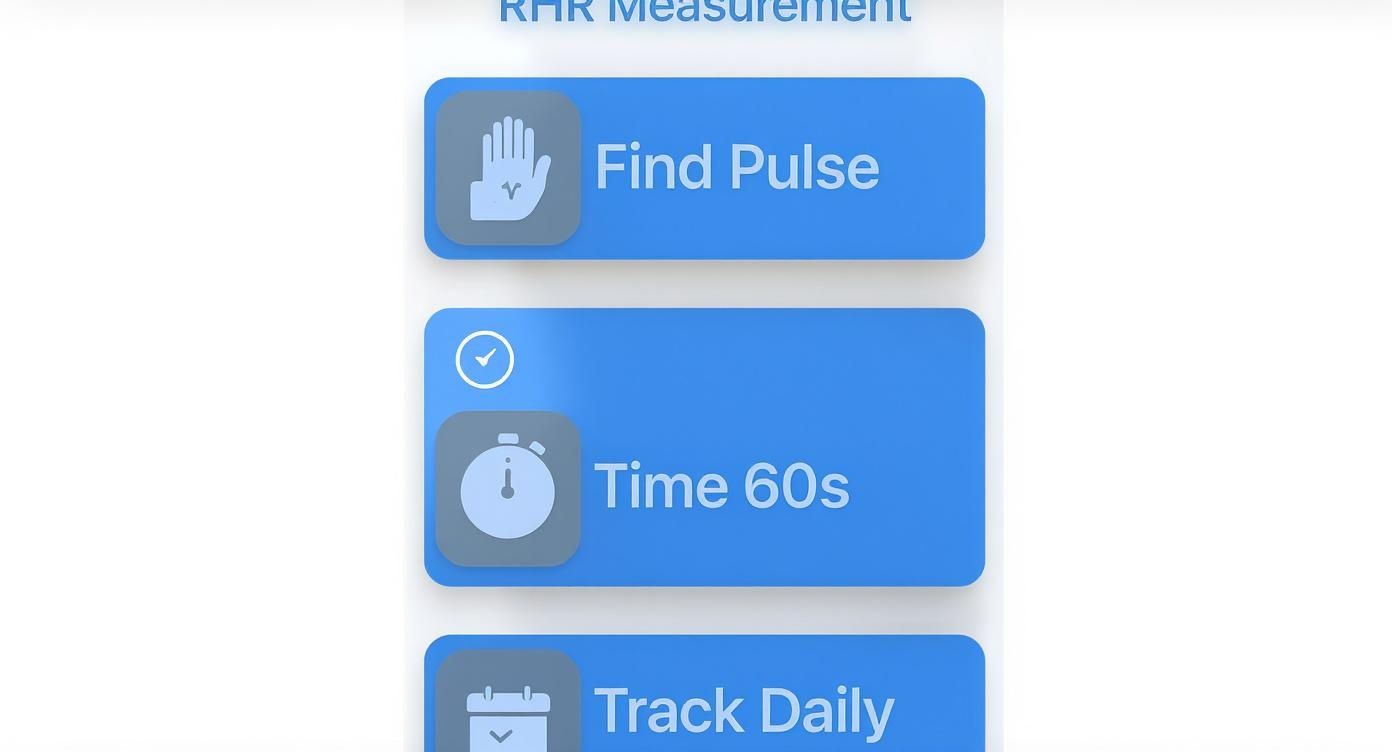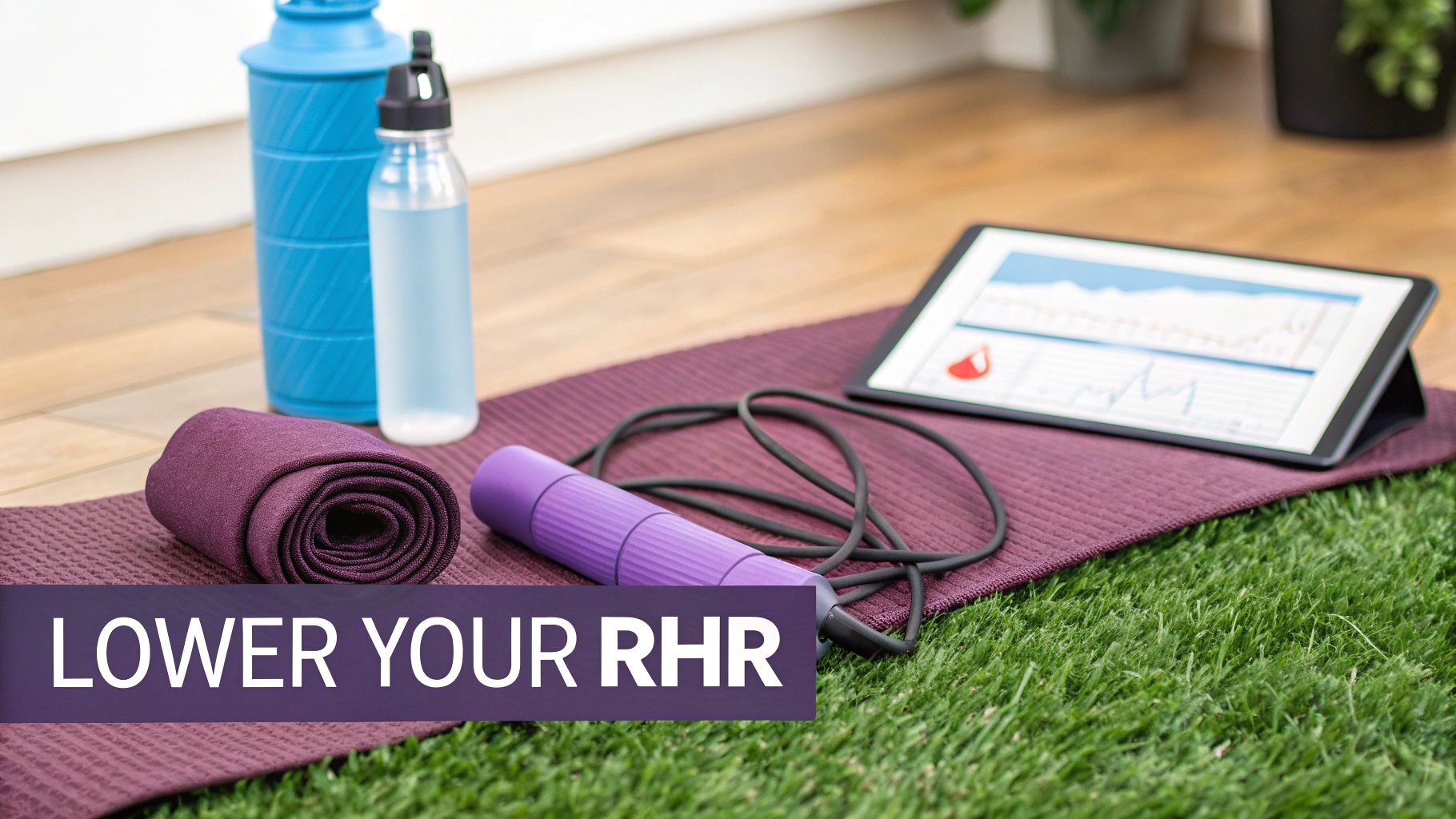
What Is Resting Heart Rate Your Complete Guide
Your resting heart rate (RHR) is a simple yet powerful snapshot of your heart's health. Think of it as your body’s engine at idle.
A lower number generally means your heart is strong and efficient. It doesn't have to work overtime to circulate blood. This single number can tell you a surprising amount about your fitness and well-being.
Unlocking Your Heart Health Numbers

So, what is a resting heart rate, really? It’s your heartbeat when you're completely relaxed—physically and mentally.
When your RHR is low, it’s a good sign. It suggests your heart muscle is in great shape and can pump a large volume of blood with each beat. A consistently high RHR, on the other hand, can be a hint that your heart is working harder than it should.
According to the American Heart Association, a normal RHR for most adults falls between 60 and 100 beats per minute (bpm). Highly trained athletes often have an RHR as low as 33 to 50 bpm because their hearts are just that efficient.
Your RHR isn't just a number; it's a dynamic reflection of your body's recovery, stress levels, and fitness. Watching it change over time can be one of the most motivating ways to see your healthy habits pay off.
Understanding Your Resting Heart Rate at a Glance
To make sense of these numbers, it helps to have a quick reference. This table breaks down what different RHR ranges might mean for an adult's cardiovascular health.
| RHR Range (Beats Per Minute) | What It Typically Means |
|---|---|
| Below 60 bpm | Often seen in very active individuals and athletes. Indicates excellent cardiovascular fitness. |
| 60–80 bpm | A healthy, normal range for most adults with a moderately active lifestyle. |
| 81–100 bpm | Still considered "normal," but a consistent RHR in this zone might suggest a need for more regular physical activity. |
| Over 100 bpm | A consistent RHR above 100 bpm (tachycardia) may signal an underlying health issue. It's wise to consult a doctor. |
Remember, these are just general guidelines. Factors like age, medication, and even stress can play a role.
What the Numbers Tell You
A lower RHR is usually the goal, but context is everything. An avid runner seeing a number in the 50s is a great sign. For most people, landing between 60–80 bpm signals solid heart health.
Consistently being in the upper end of normal (81-100 bpm) might be your body’s way of nudging you to get more active. If your heart is beating over 100 bpm at rest without a clear reason (like caffeine or stress), it’s a good idea to chat with your doctor.
These days, keeping an eye on your RHR is simple. The Smart Fitness Tracker does the work for you. It provides a clear baseline and shows how your lifestyle choices affect your heart day-to-day. This powerful device makes it easy to track your progress and stay motivated.
How to Measure Your Resting Heart Rate Accurately
Getting a solid read on your resting heart rate (RHR) is straightforward, but consistency is key. You don't need fancy gadgets to get started. This simple method is the perfect first step to understanding your body’s baseline.
The absolute best time to check is right when you wake up, before you even sit up or grab your phone. This is when your body is in its most truly rested state, giving you the purest number possible.
The Old-School Manual Method: A Step-by-Step Guide
To find your pulse, you’ve got two great options: your wrist or your neck. Both are easy-to-find spots where major arteries run just under the skin.
- Checking Your Wrist (Radial Pulse): Place the index and middle fingers of your other hand on the thumb-side of your wrist. You should feel a gentle, steady beat there.
- Checking Your Neck (Carotid Pulse): Gently place your index and middle fingers on one side of your neck, right next to your windpipe. The key here is gentle—pressing too hard can throw off your count.

Once you've locked onto that beat, start a timer for a full 60 seconds and count every thump you feel. That final number is your resting heart rate in beats per minute (bpm). For a quicker read, you can count for 30 seconds and double it.
Best Practices for Getting a True Number
To make sure your measurement is truly useful, you have to be consistent. The fewer variables that change, the more reliable your data becomes.
In clinical settings, RHR is measured under strict, controlled conditions. Researchers will have people rest quietly while they take several readings and average them out, often using precise ECG sensors. You can discover more insights about these clinical methods to appreciate the level of detail professionals go into for accuracy.
For your own measurements at home, just follow this simple checklist:
- Rest Before You Test: Lie down and chill out for at least five minutes before you even start looking for your pulse.
- Measure Daily and Average It: Your RHR can fluctuate a bit day-to-day. Check it at the same time every morning for a full week and then average those numbers. That gives you a much more stable and accurate baseline.
- Steer Clear of Stimulants: Don't measure right after having coffee, an energy drink, or anything with nicotine. They're all designed to speed things up, including your heart rate.
Using Technology for Effortless Tracking
The manual method is a classic for a reason, but today’s tech makes tracking your RHR almost ridiculously easy. Wearable devices like the Smart Fitness Tracker monitor your heart rate around the clock, even while you sleep.
It handles all the tracking for you, continuously monitoring your RHR so you get a complete picture of your trends over time, no manual counting required. This kind of automatic tracking is fantastic because it clearly shows you how things like your workouts, sleep quality, and even stress levels are impacting your heart health—a powerful tool for anyone serious about their fitness.
What Your Resting Heart Rate Number Reveals
So, you’ve got your number. What does it actually mean? Think of your resting heart rate (RHR) as a direct message from your heart.
A lower RHR is generally a good sign. It often points to a strong, efficient heart that can pump more blood with every beat. Because it’s so effective, it doesn't have to beat as often to get the job done. This is why highly trained athletes often have RHRs down in the 40s or 50s.
The infographic below walks you through the simple steps to find your pulse. Getting comfortable with this process is the first step to tracking your heart's health over time.

By consistently finding your pulse, timing it, and jotting it down, you’ll build a reliable picture of your cardiovascular baseline.
Decoding Your RHR Across Different Age Groups
While your fitness level is a huge piece of the puzzle, age also matters. Your heart rate naturally changes as you get older.
Here's a quick look at what's considered a typical RHR for different life stages.
Typical Resting Heart Rate Ranges by Age Group
| Age Group | Average RHR Range (bpm) |
|---|---|
| 18–35 | 60–95 bpm |
| 36–55 | 62–96 bpm |
| 56–75 | 65–98 bpm |
| 76+ | 68–100 bpm |
Just remember, this table is a benchmark, not a hard-and-fast rule. What's more important is your personal trend over time. If you want to track this effortlessly, the Smart Fitness Tracker automatically monitors your heart rate, helping you see the bigger picture without the manual work.
When Your Heart Rate Is Too High or Too Low
Sometimes, an RHR can fall pretty far outside the typical range, which could be your body's way of flagging a potential issue.
A consistently high resting heart rate (over 100 bpm) is known as tachycardia. On the other end of the spectrum, a very low RHR (below 60 bpm) in someone who isn't an athlete is called bradycardia.
Tachycardia can be triggered by stress, caffeine, or a fever. If it sticks around, it might be worth investigating. Bradycardia is often a badge of honor for athletes. However, if you're not very active and a low RHR comes with dizziness or fatigue, it’s definitely time to check in with a doctor.
What Affects Your Resting Heart Rate?
Your resting heart rate isn't a fixed number. It’s a dynamic metric that can tell you a new story every morning. A whole host of factors can cause it to shift up or down.
When you understand what causes these changes, you can connect the dots between your daily habits and your heart's health. It gives you a way to see the real-time impact of your lifestyle choices, putting you in the driver's seat.
Exercise, Stress, and Sleep: The Heavy Hitters
Regular physical activity is the most powerful way to lower your RHR. When you consistently do cardio—think jogging, swimming, or cycling—you’re strengthening your heart muscle. The result is a lower resting rate.
But stress and sleep are just as important. Feeling stressed out? Your body releases hormones like adrenaline, which puts your heart into a higher gear. If that stress becomes constant, it can keep your RHR permanently elevated. The same goes for a bad night's sleep.
A lower resting heart rate is a sign of quality recovery and health. You can often see the effects of late meals, evening workouts, alcohol, or sickness reflected in your nightly heart rate patterns.
Everyday Factors That Can Tip the Scales
Beyond the big three, a handful of daily habits can nudge your RHR. Something as simple as staying hydrated is huge. When you're dehydrated, your blood volume decreases, forcing your heart to beat faster.
What you eat and drink matters, too. Stimulants like caffeine are famous for causing a temporary spike in heart rate. A well-balanced diet gives your cardiovascular system the support it needs. This is especially true for athletes, and our guide to sports nutrition for endurance athletes dives deep into how the right fuel optimizes performance.
Other common things that can influence your RHR:
- Body Temperature: Your heart rate can climb when you have a fever or are in a hot environment.
- Medications: Some medicines, like beta-blockers, are designed to lower your heart rate. Others can have the opposite effect.
- Time of Day: Your heart rate is typically at its lowest during deep sleep and right after you wake up.
Proven Ways to Lower Your Resting Heart Rate
So, you understand your resting heart rate (RHR). Now comes the powerful part: taking action to improve it. Lowering your RHR is one of the best investments for your long-term heart health. The path there is paved with smart exercise and solid nutrition.
The goal is to make your heart more efficient. A stronger heart muscle can pump a greater volume of blood with every beat. When that happens, it doesn't have to work as hard during rest, which leads to a lower RHR.

Combine Cardio and Strength for Best Results
The most effective way to condition your heart is with a one-two punch: cardiovascular exercise and strength training. Cardio is fantastic for building your heart's endurance. Strength training builds lean muscle, which revs up your metabolism.
If you're looking for cardio inspiration, the Best Cardio Workouts video on the Diet & Exercise youtube channel is a great place to start. It’s full of routines you can jump into right away.
For strength training, you don’t need a gym. Using a set of Premium Resistance Bands is an effective and safe way to build muscle right from your living room. The constant tension they provide is amazing for strengthening your muscles and supporting overall fitness.
When you put these two together, you get a powerful synergistic effect. Cardio trains your heart to be a better pump, while strength training helps your body become more efficient at using all that oxygen-rich blood.
Fuel Your Heart with Smart Nutrition
Exercise is only half the battle. Your diet provides the building blocks for a strong heart and helps your body recover. What you eat can have a direct impact on your RHR.
Certain nutrients are powerhouses for your cardiovascular system. For example, Omega-3 fatty acids are famous for their heart benefits, including helping to manage both heart rate and blood pressure.
Here are a few key foods and nutrients to get on your plate:
- Omega-3 Rich Foods: Fatty fish like salmon and mackerel are fantastic, as are walnuts and flaxseeds.
- Potassium-Rich Foods: Think bananas, sweet potatoes, and spinach.
- Whole Grains: Foods like oats and brown rice are packed with fiber that can help keep your cholesterol in check.
To ensure you’re consistently getting enough of these critical nutrients, supplements can be a smart option. Our Omega-3 Fish Oil supplements are an easy way to boost your daily intake. Good nutrition also speeds up muscle repair, and you can learn more about how to recover faster in our guide.
By weaving these exercise and nutrition strategies into your daily life, you’re creating a solid foundation for a lower RHR. The real secret is consistency.
Got Questions About Resting Heart Rate? We've Got Answers.
We’ve covered what a resting heart rate is, how to track it, and ways to improve it. Let's dig into some of the most common questions to clear things up.
Can Stress and Anxiety Really Affect My Resting Heart Rate?
Absolutely. When you’re stressed or anxious, your body flips on its "fight-or-flight" switch. This floods your system with hormones like adrenaline, which tells your heart to beat faster.
The problem arises when that stress becomes chronic, keeping your RHR higher than it should be. That constant state of alert puts a lot of unnecessary wear and tear on your heart. Simple daily habits—like meditation or protecting your sleep—can work wonders for managing stress and bringing your RHR back into a healthier range.
Why Is My Resting Heart Rate Sometimes Higher in the Morning?
Waking up to a surprisingly high RHR can be confusing, but there are usually a few simple explanations. Dehydration is a big one. If you're low on fluids, your heart has to pump faster to get blood where it needs to go.
Other common culprits include a restless night's sleep, alcohol from the night before, or even some wild dreams. To get an accurate reading, consistency is key. Try to measure your RHR under the same conditions every day.
How Quickly Can I Actually Lower My Resting Heart Rate?
The timeline is different for everyone. It depends on your starting fitness level and how consistent you are with your new habits. That said, if you stick to regular aerobic exercise—aiming for 3 to 5 times per week—most people start to see a meaningful drop in their RHR within a few weeks to a couple of months.
Think of it as a marathon, not a sprint. Consistent exercise, a balanced diet, and smart stress management all work together to build a stronger, more efficient heart over time.
Looking for workout inspiration you can do right at home? The Diet & Exercise YouTube channel has some fantastic routines to help you boost your cardiovascular fitness.
Is a Resting Heart Rate of 50 BPM a Good Thing?
It depends on who you are. For a highly trained athlete, an RHR of 50 bpm is often a sign of peak cardiovascular conditioning. It means their heart is so strong and efficient that it doesn't have to beat as often.
But context is crucial. If you're not an athlete and you have a very low heart rate accompanied by symptoms like dizziness or fatigue, it’s time to talk to a doctor. This combination could be a sign of bradycardia and might point to an underlying issue.
Ready to take the next step on your fitness journey? From comfortable workout gear to the essentials that keep you going, Diet and Exercise has what you need to hit your goals. Check out the full collection and find your new favorites today at dietexerciseshop.com.
